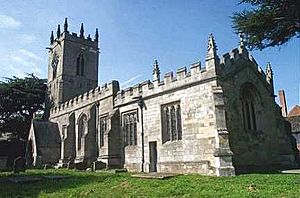St Martin of Tours' Church, Saundby facts for kids
Quick facts for kids St Martin of Tours' Church, Saundby |
|
|---|---|

St Martin of Tours' Church, Saundby, from the southeast
|
|
| Lua error in Module:Location_map at line 420: attempt to index field 'wikibase' (a nil value). | |
| OS grid reference | SK 785 879 |
| Location | Saundby, Nottinghamshire |
| Country | England |
| Denomination | Anglican |
| Website | Churches Conservation Trust |
| History | |
| Dedication | Saint Martin of Tours |
| Architecture | |
| Functional status | Redundant |
| Heritage designation | Grade I |
| Designated | 1 February 1967 |
| Architect(s) | John Loughborough Pearson Weatherley and Jones (restorations) |
| Architectural type | Church |
| Style | Perpendicular Gothic |
| Groundbreaking | 13th century |
| Specifications | |
| Materials | Stone, lead and slate roofs |
| Bells | 5 |
St Martin of Tours' Church is an old Anglican church located in the small village of Saundby, Nottinghamshire, England. It is no longer used for regular church services, which is why it's called a "redundant" church. This historic building is very important, so it's listed as a Grade I building on the National Heritage List for England. The Churches Conservation Trust now takes care of it, making sure it stays in good condition for everyone to enjoy.
History of St Martin's Church
This church has a long and interesting past, with parts of it dating back to the 13th century. Over the years, new sections were added and changes were made.
Early Beginnings: 13th to 16th Century
The church first started being built in the 1200s. The arched walkway, called an arcade, between the main part of the church (the nave) and the side section (the north aisle) was built during this time. Later, in 1504, the tall tower was added to the church.
Victorian Era Restorations
In the late 1800s, the church underwent some important repairs and updates. The chancel, which is the area around the altar, was restored by a famous architect named John Loughborough Pearson between 1885 and 1886. A few years later, in 1891, the north aisle was also restored by architects Weatherley and Jones. These updates helped preserve the church's beauty and structure.
Architecture of St Martin's
St Martin's Church is built from stone, with roofs made of lead and slate. Its outside look is mostly in the Perpendicular Gothic style, which was popular in England from the late 1300s to the early 1500s. This style is known for its tall, slender features and large windows.
Outside Features of the Church
The church's layout includes a main nave, a north aisle, and a south porch where people enter. It also has a chancel, a small room called a vestry, and a tall tower at the west end.
The Church Tower
The tower has three main sections, separated by stone bands called string courses. It stands on a strong base, or plinth, and is supported by buttresses, which are stone supports that help hold up the walls. The tower has a large window with three sections on its west side, and a four-section window above it. The very top section of the tower has double-lancet openings for the bells on each side. A clock face is also on the west side. At the very top, there's a battlemented parapet, which looks like the top of a castle wall, and eight decorative stone points called crocketted pinnacles.
The battlemented parapet continues around the top of the nave and chancel walls. The north aisle has three sections, or bays. Its north wall has a doorway that is now blocked up, and three windows with three sections each. There's a similar window on its east wall. The vestry has a blocked doorway on the west side and a double lancet window with fancy stone patterns, known as Decorated tracery. The chancel has two bays and two crocketed pinnacles on its north and south parapets. The chancel windows are also triple lancets, one on the north and east sides, and two on the south side. A special door for the priest is located between the windows on the south side. The south wall of the nave has two double and one triple lancet windows. The south porch has a sloped roof with a cross on top.
Inside Features of the Church
Inside the church, the arcade is supported by one round and one rectangular pier (a strong support column).
Altar and Baptismal Font
On the east wall of the chancel, there's a beautiful alabaster and mosaic reredos, which is a decorated screen behind the altar. In the south wall, you can see an old and fancy 14th-century piscina, which is a basin used for washing sacred vessels. It has a special curved top called an ogee head. The font, used for baptisms, is from the 1800s. It has an egg-shaped bowl with a decorative band, or frieze, covered in diamond shapes. Five eight-sided columns support the bowl, resting on a square base.
Stained Glass and Memorials
The stained glass in the east window, made in 1865, is by a company called Clayton and Bell. Other stained glass windows, made in 1885, are by Kempe. In the northeast corner, there's an alabaster memorial from 1599 dedicated to John Helwys. You can also see a stone statue, called an effigy, of a knight from the 14th century.
Church Bells
The church has a set of five bells. One bell doesn't have a date, but three were made by the Oldfield company in 1605, 1620, and 1638. The fifth bell was made by John Taylor & Co in Loughborough.
See also
- List of churches preserved by the Churches Conservation Trust in the English Midlands
- Grade I listed buildings in Nottinghamshire
- Listed buildings in Saundby

